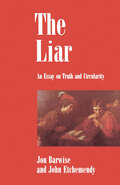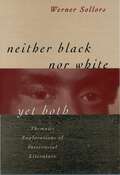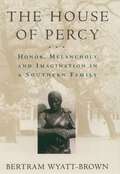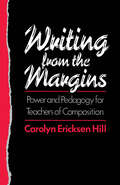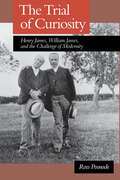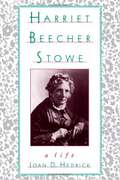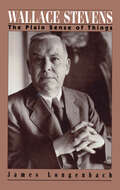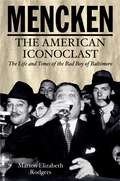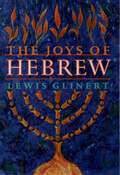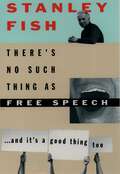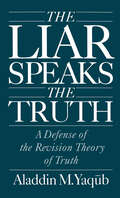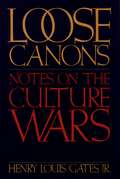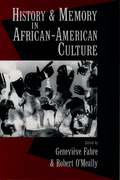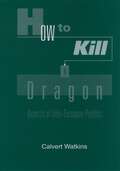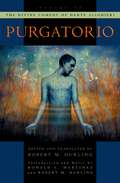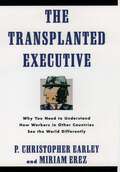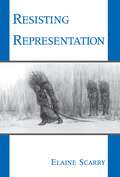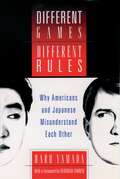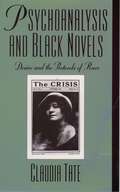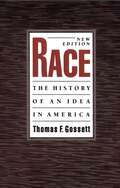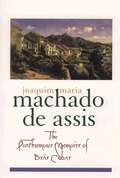- Table View
- List View
The Liar: An Essay on Truth and Circularity
by Jon Barwise John EtchemendyBringing together powerful new tools from set theory and the philosophy of language, this book proposes a solution to one of the few unresolved paradoxes from antiquity, the Paradox of the Liar. Treating truth as a property of propositions, not sentences, the authors model two distinct conceptions of propositions: one based on the standard notion used by Bertrand Russell, among others, and the other based on J.L. Austin's work on truth. Comparing these two accounts, the authors show that while the Russellian conception of the relation between sentences, propositions, and truth is crucially flawed in limiting cases, the Austinian perspective has fruitful applications to the analysis of semantic paradox. In the course of their study of a language admitting circular reference and containing its own truth predicate, Barwise and Etchemendy also develop a wide range of model-theoretic techniques--based on a new set-theoretic tool, Peter Aczel's theory of hypersets--that open up new avenues in logical and formal semantics.
Neither Black Nor White Yet Both: Thematic Explorations Of Interracial Literature
by Werner SollorsWhy can a "white" woman give birth to a "black" baby, while a "black" woman can never give birth to a "white" baby in the United States? What makes racial "passing" so different from social mobility? Why are interracial and incestuous relations often confused or conflated in literature, making "miscegenation" appear as if it were incest? When did the myth that one can tell a person's race by the moon on their fingernails originate? How did blackness get associated with "the curse of Ham" when the Biblical text makes no reference to skin color at all? Werner Sollors examines these questions and others inNeither Black Nor White Yet Both, a new and exhaustively researched exploration of "interracial literature." In the past, interracial texts have been read more for a black-white contrast of "either-or" than for an interracial realm of "neither, nor, both, and in-between." Intermarriage prohibitions have been legislated throughout the modern period and were still in the law books in the 1980s. Stories of black-white sexual and family relations have thus run against powerful social taboos. Yet much interracial literature has been written, and this book suggests its pervasiveness and offers new comparative and historical contexts for understanding it. Looking at authors from Heliodorus, John Stedman, Buffon, Thomas Jefferson, Heinrich von Kleist, Victor Hugo, Aleksandr Sergeevic Puskin, and Hans Christian Andersen, to Lydia Marie Child, Harriet Beecher Stowe, William Wells Brown, Mark Twain, Charles Chesnutt, Kate Chopin, Cirilo Villaverde, Aluisio Azevedo, and Pauline Hopkins, and on to modern writers such as Langston Hughes, Jessie Fauset, Boris Vian, and William Faulkner, Sollors ranges across time, space, and cultures, analyzing scientific and legal works as well as poetry, fiction, and the visual arts, to explore the many themes and motifs interwoven throughout interracial literature. From the etymological origins of the term "race" to the cultural sources of the "Tragic Mulatto," Sollors examines the recurrent images and ideas in this literature of love, family, and other relations between blacks, whites, and those of "mixed race." Sollors' interdisciplinary explorations of literary themes yield many insights into the history and politics of "race," and illuminate a new understanding of the relations between cultures through the focus on interracial exchanges.Neither Black Nor White Yet Bothis vital reading for anyone who seeks to understand what has been written and said about "race," and where interracial relations can go from here.
Neither Black Nor White Yet Both: Thematic Explorations of Interracial Literature
by Werner SollorsWhy can a "white" woman give birth to a "black" baby, while a "black" woman can never give birth to a "white" baby in the United States? What makes racial "passing" so different from social mobility? Why are interracial and incestuous relations often confused or conflated in literature, making "miscegenation" appear as if it were incest? When did the myth that one can tell a person's race by the moon on their fingernails originate? How did blackness get associated with "the curse of Ham" when the Biblical text makes no reference to skin color at all? Werner Sollors examines these questions and others in Neither Black Nor White Yet Both, a new and exhaustively researched exploration of "interracial literature." In the past, interracial texts have been read more for a black-white contrast of "either-or" than for an interracial realm of "neither, nor, both, and in-between." Intermarriage prohibitions have been legislated throughout the modern period and were still in the law books in the 1980s. Stories of black-white sexual and family relations have thus run against powerful social taboos. Yet much interracial literature has been written, and this book suggests its pervasiveness and offers new comparative and historical contexts for understanding it. Looking at authors from Heliodorus, John Stedman, Buffon, Thomas Jefferson, Heinrich von Kleist, Victor Hugo, Aleksandr Sergeevic Puskin, and Hans Christian Andersen, to Lydia Marie Child, Harriet Beecher Stowe, William Wells Brown, Mark Twain, Charles Chesnutt, Kate Chopin, Cirilo Villaverde, Aluisio Azevedo, and Pauline Hopkins, and on to modern writers such as Langston Hughes, Jessie Fauset, Boris Vian, and William Faulkner, Sollors ranges across time, space, and cultures, analyzing scientific and legal works as well as poetry, fiction, and the visual arts, to explore the many themes and motifs interwoven throughout interracial literature. From the etymological origins of the term "race" to the cultural sources of the "Tragic Mulatto," Sollors examines the recurrent images and ideas in this literature of love, family, and other relations between blacks, whites, and those of "mixed race." Sollors' interdisciplinary explorations of literary themes yield many insights into the history and politics of "race," and illuminate a new understanding of the relations between cultures through the focus on interracial exchanges. Neither Black Nor White Yet Both is vital reading for anyone who seeks to understand what has been written and said about "race," and where interracial relations can go from here.
The House of Percy: Honor, Melancholy, and Imagination in a Southern Family
by Bertram Wyatt-BrownThe novels of Walker Percy--The Moviegoer, Lancelot, The Second Coming, and The Thanatos Syndrome to name a few--have left a permanent mark on twentieth-century Southern fiction; yet the history of the Percy family in America matches anything, perhaps, that he could have created. Two centuries of wealth, literary accomplishment, political leadership, depression, and sometimes suicide established a fascinating legacy that lies behind Walker Percy's acclaimed prose and profound insight into the human condition. In The House of Percy, Bertram Wyatt-Brown masterfully interprets the life of this gifted family, drawing out the twin themes of an inherited inclination to despondency and an abiding sense of honor. The Percy family roots in Mississippi and Louisiana go back to "Don Carlos" Percy, an eighteenth-century soldier of fortune who amassed a large estate but fell victim to mental disorder and suicide. Wyatt-Brown traces the Percys through the slaveholding heyday of antebellum Natchez, the ravages of the Civil War (which produced the heroic Colonel William Alexander Percy, the "Gray Eagle"), and a return to prominence in the Mississippi Delta after Reconstruction. In addition, the author recovers the tragic lives and literary achievements of several Percy-related women, including Sarah Dorsey, a popular post-Civil War novelist who horrified her relatives by befriending Jefferson Davis--a married man--and bequeathing to him her plantation home, Beauvoir, along with her entire fortune. Wyatt-Brown then chronicles the life of Senator LeRoy Percy, whose climactic re-election loss in 1911 to a racist demagogue deply stung the family pride, but inspired his bold defiance to the Ku Klux Klan in the 1920s. The author goes on to tell the poignant story of poet and war hero Will Percy, the Senator's son. The weight of this family narrative found expression in Will Percy's memoirs, Lanterns on the Levee--and in the works of Walker Percy, who was reared in his cousin Will's Greenville home after the suicidal death of Walker's father and his mother's drowning. As the biography of a powerful dynasty, steeped in Sou8thern traditions and claims to kinship with English nobility, The House of Percy shows the interrelationship of legend, depression, and grand achievement. Written by a leading scholar of the South, it weaves together intensive research and thoughtful insights into a riveting, unforgettable story.
Writing from the Margins: Power and Pedagogy for Teachers of Composition
by Carolyn Ericksen HillToo often both composition teachers and their students experience knowledge and authority as unchanging entities that cannot be challenged in classroom exchanges. Drawing on feminist, cultural, and poststructuralist theory, as well as work in the rhetorical tradition and composition studies, Hill offers less debilitating methods of thinking that teachers can model for their students. Richly illustrated with examples of classroom interactions and student work, the book also shows teachers how to enrich their own intellectual and political lives within the academy.
The Trial of Curiosity: Henry James, William James, and the Challenge of Modernity
by Ross PosnockIn this important revisionist study, Posnock integrates literary and psychological criticism with social and cultural theory to make a major advance in our understanding of the life and thought of two great American figures, Henry and William James. Challenging canonical images of both brothers, Posnock is the first to place them in a rich web of cultural and intellectual affiliations comprised of a host of American and European theorists of modernity. A startlingly new Henry James emerges from a cross-disciplinary dialogue, which features Veblen, Santayana, Bourne, and Dewey, as well as Weber, Simmel, Benjamin, and Adorno.
Harriet Beecher Stowe: A Life
by Joan D. Hedrick"Up to this year I have always felt that I had no particular call to meddle with this subject....But I feel now that the time is come when even a woman or a child who can speak a word for freedom and humanity is bound to speak." Thus did Harriet Beecher Stowe announce her decision to begin work on what would become one of the most influential novels ever written. The subject she had hesitated to "meddle with" was slavery, and the novel, of course, was Uncle Tom's Cabin. Still debated today for its portrayal of African Americans and its unresolved place in the literary canon, Stowe's best-known work was first published in weekly installments from June 5, 1851 to April 1, 1852. It caused such a stir in both the North and South, and even in Great Britain, that when Stowe met President Lincoln in 1862 he is said to have greeted her with the words, "So you are the little woman who wrote the book that created this great war!" In this landmark book, the first full-scale biography of Harriet Beecher Stowe in over fifty years, Joan D. Hedrick tells the absorbing story of this gifted, complex, and contradictory woman. Hedrick takes readers into the multilayered world of nineteenth century morals and mores, exploring the influence of then-popular ideas of "true womanhood" on Stowe's upbringing as a member of the outspoken Beecher clan, and her eventful life as a writer and shaper of public opinion who was also a mother of seven. It offers a lively record of the flourishing parlor societies that launched and sustained Stowe throughout the 44 years of her career, and the harsh physical realities that governed so many women's lives. The epidemics, high infant mortality, and often disastrous medical practices of the day are portrayed in moving detail, against the backdrop of western expansion, and the great social upheaval accompanying the abolitionist movement and the entry of women into public life. Here are Stowe's public triumphs, both before and after the Civil War, and the private tragedies that included the death of her adored eighteen month old son, the drowning of another son, and the alcohol and morphine addictions of two of her other children. The daughter, sister, and wife of prominent ministers, Stowe channeled her anguish and her ambition into a socially acceptable anger on behalf of others, transforming her private experience into powerful narratives that moved a nation. Magisterial in its breadth and rich in detail, this definitive portrait explores the full measure of Harriet Beecher Stowe's life, and her contribution to American literature. Perceptive and engaging, it illuminates the career of a major writer during the transition of literature from an amateur pastime to a profession, and offers a fascinating look at the pains, pleasures, and accomplishments of women's lives in the last century.
Wallace Stevens: The Plain Sense of Things
by James LongenbachWallace Stevens the poet and Wallace Stevens the insurance executive: for more than one critical generation it has seemed as if these two men were unacquainted--that Stevens was a poet who existed only in the rarefied world of language. However, the idea that Stevens lived a double life, the author maintains, is misleading. This compelling book uncovers what Stevens liked to think of as his "ordinary" life, a life in which the demands of politics, economics, poetry, and everyday distractions coexisted, sometimes peacefully and sometimes not. Examining the full scope of Stevens's career (from the student-poet of the nineteenth century to the award-winning poet of the Cold War years), Longenbach reveals that Stevens was not only aware of events taking place around him, but often inspired by those events. The major achievements of Stevens's career are shown to coalesce around the major historical events of his lifetime (the Great Depression and two World Wars); but Longenbach also dwells on Stevens's two extended periods of poetic silence, exploring the crucial aspects of Steven's life that were not exclusively poetic. Longenbach demonstrates that through Stevens's work in surety law he was far more intimately acquainted with legal and economic concerns than most poets, and he consequently thought deeply about the strengths--and, equally important, the limitations--of poetry as a social product and force.
Mencken: The American Iconoclast
by Marion Elizabeth RodgersA towering figure on the American cultural landscape, H.L. Mencken stands out as one of our most influential stylists and fearless iconoclasts--the twentieth century's greatest newspaper journalist, a famous wit, and a constant figure of controversy. Marion Elizabeth Rodgers has written the definitive biography of Mencken, the finest book ever published about this giant of American letters. Rodgers illuminates both the public and the private man, covering the many love affairs, his happy marriage at the age of 50 to Sara Haardt, and his complicated but stimulating friendship with the famed theater critic George Jean Nathan. Rodgers vividly recreates Mencken's era: the glittering tapestry of turn-of-the-century America, the roaring twenties, depressed thirties, and the home front during World War II. But the heart of the book is Mencken. When few dared to shatter complacencies, Mencken fought for civil liberties and free speech, playing a prominent role in the Scope's Monkey Trial, battling against press censorship, and exposing pious frauds and empty uplift. The champion of our tongue in The American Language, Mencken also played a pivotal role in defining American letters through The Smart Set and The American Mercury, magazines that introduced such writers as James Joyce, F. Scott Fitzgerald, and Langston Hughes. Drawing on research in more than sixty archives including private collections in the United States and in Germany, previously unseen, on exclusive interviews with Mencken's friends, and on his love letters and FBI files, here is the full portrait of one of America's most colorful and influential men. "This biography, the best ever on the sage of Baltimore, is exhaustive but never exhausting, and offers readers more than moderate intelligence and an awfully good time." --Martin Nolan, Boston Globe
The Joys of Hebrew
by Lewis GlinertWhen do you say mazal tov? What is the English equivalent to the Talmudic expression Alya ve-kots ba ("a sheep's tail with a thorn in it")? What is a get, a golem, a kibbutz, a chalutz? What four plant species are waved during prayers on the harvest festival of Sukkot? You'll find answers to these questions and hundreds of others--all in clear English--in this remarkable collection of the best known, most loved Hebrew words and phrases in the English speaking world. From Acharon to Zohar, this informative and often humorous dictionary features over six hundred Hebrew words and expressions arranged in alphabetical order (the Roman alphabet is used throughout, as well as Hebrew head words). The first such guide to Hebrew, this volume is more than a mere lexicon--it is a jubilant celebration of Hebrew itself, a treasure trove of Jewish wit, wisdom, culture, and tradition. Lewis Glinert provides a concise definition of each entry, and then illustrates the word's usage with generous passages from the Bible and the Talmud, the prayers and the sayings of famous rabbis, the razor's edge of Jewish humor, excerpts from the work of Elie Wiesel, Adin Steinsaltz, S.Y. Agnon, Martin Buber, Naomi Shemer and other contemporary writers, folklore from all over the Jewish world, and colorful slices of modern Israeli life. There are words directly related to the practice of religion, such as amida (a prayer said standing, under one's breath, essentially a cry for help--for wisdom, health, peace, prosperity, and so forth) as well as the names of all the Jewish holy days and religious customs; words from everyday Jewish experience, such peot (the long sidecurls customarily worn by the Chasidim); many words familiar from their use in Israel, such as rega (literally, "one moment," it is the Israeli equivalent of Mexico's mañana) or miluim (army reserve service); and many traditional sayings, such as Tsarat rabim chatsi nechama ("A public woe is half a comfort"). In addition, Glinert provides at the back of the book an alphabetical list of familiar biblical names in English, Sephardi/Israeli Hebrew, and Ashkenazi Hebrew. This celebration of Hebrew language and culture is a joy to read and to use. Everyone from Bible students to collectors of Judaica, from Woody Allen fans to people planning a journey to the Holy Land, will be delighted by this informative volume.
There's No Such Thing As Free Speech: And It's a Good Thing, Too
by Stanley FishIn an era when much of what passes for debate is merely moral posturing--traditional family values versus the cultural elite, free speech versus censorship--or reflexive name-calling--the terms "liberal" and "politically correct," are used with as much dismissive scorn by the right as "reactionary" and "fascist" are by the left--Stanley Fish would seem an unlikely lightning rod for controversy. A renowned scholar of Milton, head of the English Department of Duke University, Fish has emerged as a brilliantly original critic of the culture at large, praised and pilloried as a vigorous debunker of the pieties of both the left and right. His mission is not to win the cultural wars that preoccupy the nation's attention, but rather to redefine the terms of battle. In There's No Such Thing as Free Speech, Fish takes aim at the ideological gridlock paralyzing academic and political exchange in the nineties. In his witty, accessible dissections of the swirling controversies over multiculturalism, affirmative action, canon revision, hate speech, and legal reform, he neatly eviscerates both the conservatives' claim to possession of timeless, transcendent values (the timeless transcendence of which they themselves have conveniently identified), and the intellectual left's icons of equality, tolerance, and non-discrimination. He argues that while conservative ideologues and liberal stalwarts might disagree vehemently on what is essential to a culture, or to a curriculum, both mistakenly believe that what is essential can be identified apart from the accidental circumstances (of time and history) to which the essential is ritually opposed. In the book's first section, which includes the five essays written for Fish's celebrated debates with Dinesh D'Souza (the author and former Reagan White House policy analyst), Fish turns his attention to the neoconservative backlash. In his introduction, Fish writes, "Terms that come to us wearing the label 'apolitical'--'common values', 'fairness', 'merit', 'color blind', 'free speech', 'reason'--are in fact the ideologically charged constructions of a decidedly political agenda. I make the point not in order to level an accusation, but to remove the sting of accusation from the world 'politics' and redefine it as a synonym for what everyone inevitably does." Fish maintains that the debate over political correctness is an artificial one, because it is simply not possible for any party or individual to occupy a position above or beyond politics. Regarding the controversy over the revision of the college curriculum, Fish argues that the point is not to try to insist that inclusion of ethnic and gender studies is not a political decision, but "to point out that any alternative curriculum--say a diet of exclusively Western or European texts--would be no less politically invested." In Part Two, Fish follows the implications of his arguments to a surprising rejection of the optimistic claims of the intellectual left that awareness of the historical roots of our beliefs and biases can allow us, as individuals or as a society, to escape or transcend them. Specifically, he turns to the movement for reform of legal studies, and insists that a dream of a legal culture in which no one's values are slighted or declared peripheral can no more be realized than the dream of a concept of fairness that answers to everyone's notions of equality and jsutice, or a yardstick of merit that is true to everyone's notions of worth and substance. Similarly, he argues that attempts to politicize the study of literature are ultimately misguided, because recharacterizations of literary works have absolutely no impact on the mainstream of political life. He concludes his critique of the academy with "The Unbearable Ugliness of Volvos," an extraordinary look at some of the more puzzing, if not out-and-out masochistic, characteristics of a life in academia. Penetrating, fearless, and brilliantly argued, There's No Such Thing as Free Speech captures the essential Fish. It is must reading for anyone who cares about the outcome
The Liar Speaks the Truth: A Defense of the Revision Theory of Truth
by Aladdin M. YaqubIn this book, Yaqūb describes a simple conception of truth and shows that it yields a semantical theory that accommodates the whole range of our seemingly conflicting intuitions about truth. This conception takes the Tarskian biconditionals (such as "The sentence 'Johannes loved Clara' is true if and only if Johannes loved Clara") as correctly and completely defining the notion of truth. The semantical theory, which is called the revision theory, that emerges from this conception paints a metaphysical picture of truth as a property whose applicability is given by a revision process rather than by a fixed extension. The main advantage of this revision process is its ability to explain why truth seems in many cases almost redundant, in others substantial, and yet in others paradoxical (as in the famous Liar). Yaqūb offers a comprehensive defense of the revision theory of truth by developing consistent and adequate formal semantics for languages in which all sorts of problematic sentences (Liar and company) can be constructed. Yaqūb concludes by introducing a logic of truth that further demonstrates the adequacy of the revision theory.
Loose Canons: Notes on the Culture Wars
by Henry Louis GatesMulticulturalism. It has been the subject of cover stories in Time and Newsweek, as well as numerous articles in newspapers and magazines around America. It has sparked heated jeremiads by George Will, Dinesh D'Sousa, and Roger Kimball. It moved William F. Buckley to rail against Stanley Fish and Catherine Stimpson on "Firing Line." It is arguably the most hotly debated topic in America today--and justly so. For whether one speaks of tensions between Hasidim and African-Americans in Crown Heights, or violent mass protests against Moscow in ethnic republics such as Armenia, or outright war between Serbs and Bosnians in the former Yugoslavia, it is clear that the clash of cultures is a worldwide problem, deeply felt, passionately expressed, always on the verge of violent explosion. Problems of this magnitude inevitably frame the discussion of "multiculturalism" and "cultural diversity" in the American classroom as well. In Loose Canons, one of America's leading literary and cultural critics, Henry Louis Gates, Jr., offers a broad, illuminating look at this highly contentious issue. Gates agrees that our world is deeply divided by nationalism, racism, and sexism, and argues that the only way to transcend these divisions--to forge a civic culture that respects both differences and similarities--is through education that respects both the diversity and commonalities of human culture. His is a plea for cultural and intercultural understanding. (You can't understand the world, he observes, if you exclude 90 percent of the world's cultural heritage.) We feel his ideas most strongly voiced in the concluding essay in the volume, "Trading on the Margin." Avoiding the stridency of both the Right and the Left, Gates concludes that the society we have made simply won't survive without the values of tolerance, and cultural tolerance comes to nothing without cultural understanding. Henry Louis Gates is one of the most visible and outspoken figures on the academic scene, the subject of a cover story in The New York Times Sunday Magazine and a major profile in The Boston Globe, and a much sought-after commentator. And as one of America's foremost advocates of African-American Studies (he is head of the department at Harvard), he has reflected upon the varied meanings of multiculturalism throughout his professional career, long before it became a national controversy. What we find in these pages, then, is the fruit of years of reflection on culture, racism, and the "American identity," and a deep commitment to broadening the literary and cultural horizons of all Americans.
History and Memory in African-American Culture
by Genevieve Fabre Robert O'MeallyAs Nathan Huggins once stated, altering American history to account fully for the nation's black voices would change the tone and meaning--the frame and the substance--of the entire story. Rather than a sort of Pilgrim's Progress tale of bold ascent and triumph, American history with the black parts told in full would be transmuted into an existential tragedy, closer, Huggins said, to Sartre's No Exit than to the vision of life in Bunyan. The relation between memory and history has received increasing attention both from historians and from literary critics. In this volume, a group of leading scholars has come together to examine the role of historical consciousness and imagination in African-American culture. The result is a complex picture of the dynamic ways in which African-American historical identity constantly invents and transmits itself in literature, art, oral documents, and performances. Each of the scholars represented has chosen a different "site of memory"--from a variety of historical and geographical points, and from different ideological, theoretical, and artistic perspectives. Yet the book is unified by a common concern with the construction of an emerging African-American cultural memory. The renowned group of contributors, including Hazel Carby, Werner Sollors, Vèvè Clark, Catherine Clinton, and Nellie McKay, among others, consists of participants of the five-year series of conferences at the DuBois Institute at Harvard University, from which this collection originated. Conducted under the leadership of Geneviève Fabre, Melvin Dixon, and the late Nathan Huggins, the conferences--and as a result, this book--represent something of a cultural moment themselves, and scholars and students of American and African-American literature and history will be richer as a result.
How to Kill a Dragon: Aspects of Indo-European Poetics
by Calvert WatkinsIn How to Kill a Dragon Calvert Watkins follows the continuum of poetic formulae in Indo-European languages, from Old Hittite to medieval Irish. He uses the comparative method to reconstruct traditional poetic formulae of considerable complexity that stretch as far back as the original common language. Thus, Watkins reveals the antiquity and tenacity of the Indo-European poetic tradition. Watkins begins this study with an introduction to the field of comparative Indo-European poetics; he explores the Saussurian notions of synchrony and diachrony, and locates the various Indo-European traditions and ideologies of the spoken word. Further, his overview presents case studies on the forms of verbal art, with selected texts drawn from Indic, Iranian, Greek, Latin, Hittite, Armenian, Celtic, and Germanic languages. In the remainder of the book, Watkins examines in detail the structure of the dragon/serpent-slaying myths, which recur in various guises throughout the Indo-European poetic tradition. He finds the "signature" formula for the myth--the divine hero who slays the serpent or overcomes adversaries--occurs in the same linguistic form in a wide range of sources and over millennia, including Old and Middle Iranian holy books, Greek epic, Celtic and Germanic sagas, down to Armenian oral folk epic of the last century. Watkins argues that this formula is the vehicle for the central theme of a proto-text, and a central part of the symbolic culture of speakers of the Proto-Indo-European language: the relation of humans to their universe, the values and expectations of their society. Therefore, he further argues, poetry was a social necessity for Indo- European society, where the poet could confer on patrons what they and their culture valued above all else: "imperishable fame."
The Divine Comedy of Dante Alighieri: Volume 2: Purgatorio (First Avenue Classics)
by Robert M. DurlingIn the early 1300s, Dante Alighieri set out to write the three volumes which make the up The Divine Comedy. Purgatorio is the second volume in this set and opens with Dante the poet picturing Dante the pilgrim coming out of the pit of hell. Similar to the Inferno (34 cantos), this volume is divided into 33 cantos, written in tercets (groups of 3 lines). The English prose is arranged in tercets to facilitate easy correspondence to the verse form of the Italian on the facing page, enabling the reader to follow both languages line by line. In an effort to capture the peculiarities of Dante's original language, this translation strives toward the literal and sheds new light on the shape of the poem. Again the text of Purgatorio follows Petrocchi's La Commedia secondo l'antica vulgata, but the editor has departed from Petrocchi's readings in a number of cases, somewhat larger than in the previous Inferno, not without consideration of recent critical readings of the Comedy by scholars such as Lanza (1995, 1997) and Sanguineti (2001). As before, Petrocchi's punctuation has been lightened and American norms have been followed. However, without any pretensions to being "critical", the text presented here is electic and being not persuaded of the exclusive authority of any manuscript, the editor has felt free to adopt readings from various branches of the stemma. One major addition to this second volume is in the notes, where is found the Intercantica - a section for each canto that discusses its relation to the Inferno and which will make it easier for the reader to relate the different parts of the Comedy as a whole.
The Transplanted Executive: Why You Need To Understand How Workers In Other Countries See The World Differently
by P. Christopher Earley Miriam ErezResisting Representation
by Elaine ScarryRenowned scholar Elaine Scarry's book, The Body in Pain, has been called by Susan Sontag "extraordinary...large-spirited, heroically truthful." The Los Angeles Times called it "brilliant, ambitious, and controversial." Now Oxford has collected some of Scarry's most provocative writing. This collection of essays deals with the complicated problems of representation in diverse literary and cultural genres--from her beloved sixth-century philosopher Boethius, through the nineteenth-century novel, to twentieth-century advertising. qWe often assume that all areas of experience are equally available for representation. On the contrary, these essays present discussions of experiences and concepts that challenge, defeat, or block representation. Physical pain, physical labor, the hidden reflexes of cognition and its judgments about the coherence or incoherence of the world are all phenomena that test the resources of language. Using primarily literary sources (works by Hardy, Beckett, Boethius, Thackeray, and others), Scarry also draws on painting, medical advertising, and philosophic dialogue to probe the limitations of expression and representation. Resisting Representation celebrates language. It looks at the problematic areas of expression not at the moment when representation is resisted, but at the moment when that resistance is at last overcome, thus suggesting a domain of plenitude and inclusion.
Different Games, Different Rules: Why Americans and Japanese Misunderstand Each Other
by Haru YamadaJapan and the United States are in closer contact politically and economically than ever before, yet in many ways our nations are as far from mutual understanding as ever. Misconceptions and miscommunications between East and West continue to plague this important relationship, frustrating the best efforts of both cultures to work together. Stereotypes abound: Americans see Japanese as evasive and inscrutable, while Japanese see Americans as pushy and selfish. What causes these persistent misunderstandings, and what can be done to avoid them? Fluent in both languages and at home in both cultures, Haru Yamada brings an insiders perspective and a linguists training to this difficult question, illuminating the many reasons why Americans and Japanese misunderstand one another. Social organization, she explains, shapes the way we talk. Because American and Japanese cultures value different kinds of social relationships, they play different language games with different sets of rules. In America, for instance, Aesop's fable about the grasshopper and the ants ends with the ants scorning the foolhardy grasshopper. In Japan, however, the story has a very different ending: the ants invite the grasshopper in to share their winter meal, as they appreciate how his singing spurred them on during their summer labors. In the difference between these two endings, argues Yamada, lies an important lesson: Americans, because of their unique political history, value independence and individuality, while Japanese value mutual dependency and interconnectedness. The language of both cultures is designed to display and reinforce these values so that words, phrases and expressions in one language can have completely different connotations in another, leading to all manner of misunderstanding. Yamada provides numerous examples. In Japan, for instance, silence is valued and halting speech is considered more honest and thoughtful than fluid speech, while in America forthright, polished speech is valued. Likewise, the Japanese use word order to express emphasis, while Americans use vocal stress: a listener unaware of this difference may easily misunderstand the import of a sentence. In a lucid and insightful discussion, Yamada outlines the basic differences between Japanese and American English and analyzes a number of real-life business and social interactions in which these differences led to miscommunication. By understanding how and why each culture speaks in the way that it does, Yamada shows, we can learn to avoid frustrating and damaging failures of communication. Different Games, Different Rules is essential reading for anyone who travels to or communicates regularly with Japan, whether they are scientists, scholars, tourists, or business executives. But as Deborah Tannen notes in her Foreword to the book, even those who will never travel to Japan, do business with a Japanese company, or talk to a person from that part of the world, will find the insights of this book illuminating and helpful, because the greatest benefit that comes of understanding another culture is a better and deeper understanding of one's own.
Psychoanalysis And Black Novels: Desire And The Protocols Of Race
by Claudia TateAlthough psychoanalytic theory is one of the most potent and influential tools in contemporary literary criticism, to date it has had very little impact on the study of African American literature. Critical methods from the disciplines of history, sociology, and cultural studies have dominated work in the field. Now, in this exciting new book by the author ofDomestic Allegories: The Black Heroine's Text at the Turn of the Century, Claudia Tate demonstrates that psychoanalytic paradigms can produce rich and compelling readings of African American textuality. With clear and accessible summaries of key concepts in Freud, Lacan, and Klein, as well as deft reference to the work of contemporary psychoanalytic critics of literature, Tate explores African- American desire, alienation, and subjectivity in neglected novels by Emma Kelley, W.E.B. Du Bois, Richard Wright, Zora Neale Hurston, and Nella Larsen. Her pioneering approach highlights African American textual realms within and beyond those inscribing racial oppression and modes of black resistance. A superb introduction to psychoanalytic theory and its applications for African American literature and culture, this book creates a sophisticated critical model of black subjectivity and desire for use in the study of African American texts.
Psychoanalysis and Black Novels: Desire and the Protocols of Race (Race and American Culture)
by Claudia TateAlthough psychoanalytic theory is one of the most potent and influential tools in contemporary literary criticism, to date it has had very little impact on the study of African American literature. Critical methods from the disciplines of history, sociology, and cultural studies have dominated work in the field. Now, in this exciting new book by the author of Domestic Allegories: The Black Heroine's Text at the Turn of the Century, Claudia Tate demonstrates that psychoanalytic paradigms can produce rich and compelling readings of African American textuality. With clear and accessible summaries of key concepts in Freud, Lacan, and Klein, as well as deft reference to the work of contemporary psychoanalytic critics of literature, Tate explores African- American desire, alienation, and subjectivity in neglected novels by Emma Kelley, W.E.B. Du Bois, Richard Wright, Zora Neale Hurston, and Nella Larsen. Her pioneering approach highlights African American textual realms within and beyond those inscribing racial oppression and modes of black resistance. A superb introduction to psychoanalytic theory and its applications for African American literature and culture, this book creates a sophisticated critical model of black subjectivity and desire for use in the study of African American texts.
Race: The History of an Idea in America (Race and American Culture)
by Thomas F. GossettWhen Thomas Gossett's Race: The History of an Idea in America appeared in 1963, it explored the impact of race theory on American letters in a way that anticipated the investigation of race and culture being conducted today. Bold, rigorous, and broad in scope, Gossett's book quickly established itself as a critical resource to younger scholars seeking a candid, theoretically sophisticated treatment of race in American cultural history. Here, reprinted without change, is Gossett's classic study, making available to a new generation of scholars a lucid, accessibly written volume that ranges from colonial race theory and its European antecedents, through eighteenth- and nineteenth- century race pseudoscience, to the racialist dimension of American thought and literature emerging against backgrounds such as Anglo- Saxonism, westward expansion, Social Darwinism, xenophobia, World War I, and modern racial theory. Featuring a new afterword by the author, an introduction by series editors Shelley Fisher Fishkin and Arnold Rampersad, and a bibliographic essay by Maghan Keita, this indispensable book, whose first edition helped change the way scholars discussed race, will richly reward scholars of American Studies, American Literature, and African-American Studies.
The Posthumous Memoirs of Brás Cubas (Library of Latin America)
by Joaquim Maria Machado de Assis"Be aware that frankness is the prime virtue of a dead man," writes the narrator of The Posthumous Memoirs of Brás Cubas. But while he may be dead, he is surely one of the liveliest characters in fiction, a product of one of the most remarkable imaginations in all of literature, Brazil's greatest novelist of the nineteenth century, Joaquim Maria Machado de Assis. By turns flippant and profound, The Posthumous Memoirs of Brás Cubas is the story of an unheroic man with half-hearted political ambitions, a harebrained idea for curing the world of melancholy, and a thousand quixotic theories unleashed from beyond the grave. It is a novel that has influenced generations of Latin American writers but remains refreshingly and unforgettably unlike anything written before or after it. Newly translated by Gregory Rabassa and superbly edited by Enylton de Sá Rego and Gilberto Pinheiro Passos, this Library of Latin America edition brings to English-speaking readers a literary delight of the highest order.
